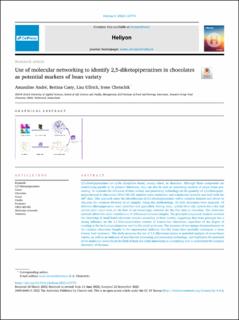Please use this identifier to cite or link to this item:
https://doi.org/10.21256/zhaw-25927Full metadata record
| DC Field | Value | Language |
|---|---|---|
| dc.contributor.author | André, Amandine | - |
| dc.contributor.author | Casty, Bettina | - |
| dc.contributor.author | Ullrich, Lisa | - |
| dc.contributor.author | Chetschik, Irene | - |
| dc.date.accessioned | 2022-11-03T16:23:41Z | - |
| dc.date.available | 2022-11-03T16:23:41Z | - |
| dc.date.issued | 2022 | - |
| dc.identifier.issn | 2405-8440 | de_CH |
| dc.identifier.uri | https://digitalcollection.zhaw.ch/handle/11475/25927 | - |
| dc.description.abstract | 2,5-diketopiperazines are cyclic dipeptides found, among others, in chocolate. Although those compounds are contributing greatly to its pleasant bitterness, they can also be seen as interesting markers of cocoa beans processing. To evaluate the influence of bean variety and processing technology on the quantity of 2,5-diketopiperazines formed in chocolates, HPLC-MS/MS analyses were conducted, and a molecular network was built with the MS2 data. This approach eases the identification of 2,5-diketopiperazines within complex datasets and allows to visualize the chemical diversity of all samples. Using this methodology, 33 dark chocolates were analysed. 18 different diketopiperazine were identified and quantified. Among them, cyclo(L-ile-L-val), cyclo(L-leu-L-ile) and cyclo(L-phe-L-phe) were, to the best of our knowledge, detected for the first time in chocolate. The molecular network allows the clear visualization of differences between samples. The principal component analysis revealed the clustering of small batch chocolate samples according to bean variety, suggesting that bean genotype has a strong influence on the 2,5-diketopiperazines content of bean-to-bar chocolates, regardless of the degree of roasting or the technological process used by the small producers. The presence of two unique diastereoisomers in the classical chocolates bought in the supermarket indicates that the beans have probably undergone a more intense heat treatment. This study proposes the use of 2,5-diketopiperazines as potential markers of cocoa beans variety, as well as an indicator of post-harvest processing and processing technology, and highlights the potential of the molecular networks in the field of food and drink innovation as a promising tool to understand the complex chemistry of flavours. | de_CH |
| dc.language.iso | en | de_CH |
| dc.publisher | Elsevier | de_CH |
| dc.relation.ispartof | Heliyon | de_CH |
| dc.rights | https://creativecommons.org/licenses/by/4.0/ | de_CH |
| dc.subject | 2,5-Diketopiperazines | de_CH |
| dc.subject | Cacao | de_CH |
| dc.subject | Chocolate | de_CH |
| dc.subject | Cocoa | de_CH |
| dc.subject | Criollo | de_CH |
| dc.subject | Forastero | de_CH |
| dc.subject | HPLC-MS/MS | de_CH |
| dc.subject | Molecular network | de_CH |
| dc.subject | Trinitario | de_CH |
| dc.subject.ddc | 664: Lebensmitteltechnologie | de_CH |
| dc.title | Use of molecular networking to identify 2,5-diketopiperazines in chocolates as potential markers of bean variety | de_CH |
| dc.type | Beitrag in wissenschaftlicher Zeitschrift | de_CH |
| dcterms.type | Text | de_CH |
| zhaw.departement | Life Sciences und Facility Management | de_CH |
| zhaw.organisationalunit | Institut für Lebensmittel- und Getränkeinnovation (ILGI) | de_CH |
| dc.identifier.doi | 10.1016/j.heliyon.2022.e10770 | de_CH |
| dc.identifier.doi | 10.21256/zhaw-25927 | - |
| zhaw.funding.eu | No | de_CH |
| zhaw.issue | 9 | de_CH |
| zhaw.originated.zhaw | Yes | de_CH |
| zhaw.pages.start | e10770 | de_CH |
| zhaw.publication.status | publishedVersion | de_CH |
| zhaw.volume | 8 | de_CH |
| zhaw.publication.review | Peer review (Publikation) | de_CH |
| zhaw.webfeed | LM-Chemie | de_CH |
| zhaw.author.additional | No | de_CH |
| zhaw.display.portrait | Yes | de_CH |
| Appears in collections: | Publikationen Life Sciences und Facility Management | |
Files in This Item:
| File | Description | Size | Format | |
|---|---|---|---|---|
| 2022_Andre-etal_Use-molecular-networking-identify-diketopiperazine-chocolates-bean-variety.pdf | 1.5 MB | Adobe PDF |  View/Open |
Show simple item record
André, A., Casty, B., Ullrich, L., & Chetschik, I. (2022). Use of molecular networking to identify 2,5-diketopiperazines in chocolates as potential markers of bean variety. Heliyon, 8(9), e10770. https://doi.org/10.1016/j.heliyon.2022.e10770
André, A. et al. (2022) ‘Use of molecular networking to identify 2,5-diketopiperazines in chocolates as potential markers of bean variety’, Heliyon, 8(9), p. e10770. Available at: https://doi.org/10.1016/j.heliyon.2022.e10770.
A. André, B. Casty, L. Ullrich, and I. Chetschik, “Use of molecular networking to identify 2,5-diketopiperazines in chocolates as potential markers of bean variety,” Heliyon, vol. 8, no. 9, p. e10770, 2022, doi: 10.1016/j.heliyon.2022.e10770.
ANDRÉ, Amandine, Bettina CASTY, Lisa ULLRICH und Irene CHETSCHIK, 2022. Use of molecular networking to identify 2,5-diketopiperazines in chocolates as potential markers of bean variety. Heliyon. 2022. Bd. 8, Nr. 9, S. e10770. DOI 10.1016/j.heliyon.2022.e10770
André, Amandine, Bettina Casty, Lisa Ullrich, and Irene Chetschik. 2022. “Use of Molecular Networking to Identify 2,5-Diketopiperazines in Chocolates as Potential Markers of Bean Variety.” Heliyon 8 (9): e10770. https://doi.org/10.1016/j.heliyon.2022.e10770.
André, Amandine, et al. “Use of Molecular Networking to Identify 2,5-Diketopiperazines in Chocolates as Potential Markers of Bean Variety.” Heliyon, vol. 8, no. 9, 2022, p. e10770, https://doi.org/10.1016/j.heliyon.2022.e10770.
Items in DSpace are protected by copyright, with all rights reserved, unless otherwise indicated.